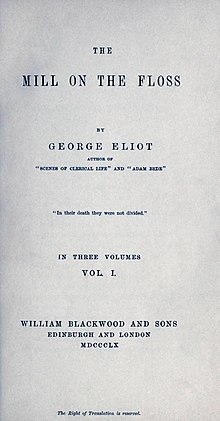The Mill on the Floss

First edition title page
|
|
| Author | George Eliot |
|---|---|
| Country | United Kingdom |
| Language | English |
| Genre | Novel |
| Publisher | William Blackwood and Sons, Edinburgh and London |
|
Publication date
|
1860 |
| Media type | Print (hardback & paperback) |
The Mill on the Floss is a novel by George Eliot (Mary Ann Evans), first published in three volumes in 1860 by William Blackwood. The first American edition was published by Thomas Y. Crowell Co., New York.
The novel spans a period of 10 to 15 years and details the lives of Tom and Maggie Tulliver, siblings growing up at Dorlcote Mill on the River Floss at its junction with the more minor River Ripple near the village of St. Ogg's in Lincolnshire, England. Both the river and the village are fictional.
The novel is initially set in the late 1820s or early 1830s – a number of historical references place the events in the book after the Napoleonic Wars but before the Reform Act of 1832. (In chapter 3, the character Mr. Riley is described as an "auctioneer and appraiser thirty years ago," placing the opening events of the novel in approximately 1829, thirty years before the novel's composition in 1859. Additionally, in chapter 8, Mr. Tulliver and Mr. Deane discuss the Duke of Wellington and his "conduct in the Catholic Question," a conversation that could only take place after 1828 when Wellington became Prime Minister and supported a bill for Catholic Emancipation). The novel includes autobiographical elements, and reflects the disgrace that George Eliot (Mary Ann Evans) herself experienced while in a lengthy relationship with a married man,George Henry Lewes.
Maggie Tulliver is the central character of the book. The story begins when she is 9 years old, 13 years into her parents' marriage. Her relationship with her older brother Tom, and her romantic relationships with Philip Wakem (a hunchbacked, sensitive, and intellectual friend) and with Stephen Guest (a vivacious young socialite in St. Ogg's and assumed fiancé of Maggie's cousin Lucy Deane) constitute the most significant narrative threads.
Tom and Maggie have a close yet complex bond, which continues throughout the novel. Their relationship is coloured by Maggie's desire to recapture the unconditional love her father provides before his death. Tom's pragmatic and reserved nature clashes with Maggie's idealism and fervor for intellectual gains and experience. Various family crises, including bankruptcy, Mr. Tulliver's rancorous relationship with Philip Wakem's father, which results in the loss of the mill, and Mr. Tulliver's untimely death, serve both to intensify Tom's and Maggie's differences and to highlight their love for each other. To help his father repay his debts, Tom leaves school to enter a life of business. He eventually finds a measure of success, restoring the family's former estate. Meanwhile, Maggie languishes in the impoverished Tulliver home, her intellectual aptitude wasted in her socially isolated state. She passes through a period of intense spirituality, during which she renounces the world, spurred by Thomas à Kempis's The Imitation of Christ.
...
Wikipedia
